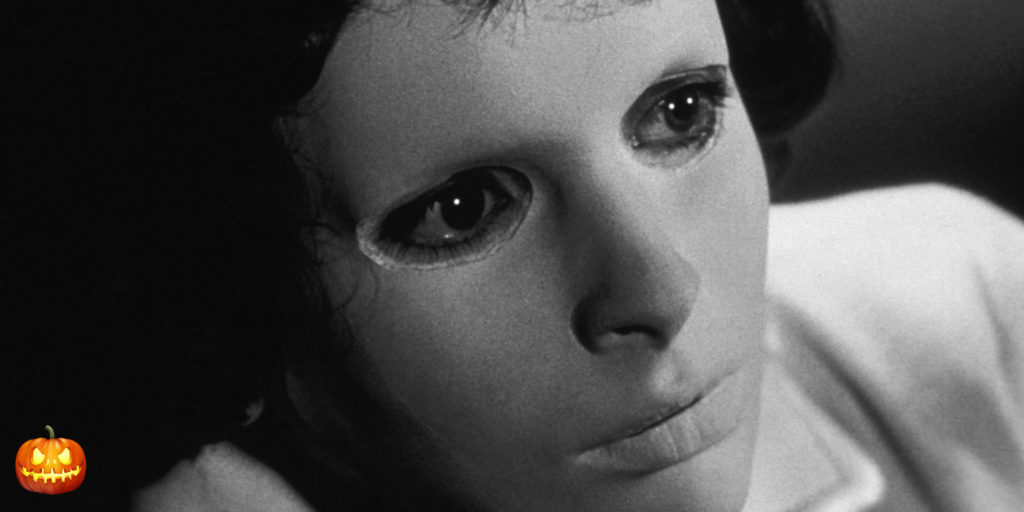The road to Halloween is paved with good films. Wherein we countdown to the spirited season with a hundred doses of horror. 75 days to go.
1960 saw the release of three major horror films which changed the genre forever. One of those films was Hitchcock’s Psycho, another was Michael Powell’s underrated Peeping Tom and the other was George Franju’s Eyes Without a Face. While Psycho is perhaps the better known of the three and one of the most referenced films in cinema history, Eyes Without a Face is perhaps the more effective film out of the two for its sheer level of disturbing, haunting visuals and chilling atmosphere.
Shot in crisp black and white, Eyes Without a Face is a gothic fairytale, crossed between a film noir with a good old dash of psychological horror thrown in. More importantly, it’s not like anything that had come before it and it still stands up today.
The film opens with a woman driving at night along a riverbank. She stops and dumps a corpse in the river. After the body is recovered, Dr. Génessier (Pierre Brasseur) identifies the remains as those of his missing daughter, Christiane Génessier (Édith Scob). Whose face was horribly disfigured in an automobile accident that occurred before her disappearance, for which her father was responsible.
Read More on the Film Road to Halloween: Zombieland
However, Christiane is actually still very much alive and Dr. Génessier works tirelessly to give her a new face. He does so however by kidnapping young women and attempting to carry out face transplants. None of these procedures are successful. Still, driven by guilt, the doctor keeps on trying along with the assistance of Louise (Alida Valli). But how long will his crimes go unnoticed?
Dr. Génessier doesn’t exactly fit into the mad scientist’s trope, as we fully buy into his motivations and we feel a level of empathy towards him. He’s a complex character, a rarity in the horror genre. He is supported by his assistant, Louise who is also very intriguing. Louise is cunning, and seems more than happy to help gather her victims to aid the doctor’s latest experiment.
The real champion of the film is the character of Christiane. She is hovering between life and death, simply existing in her own living nightmare. Essentially, she has been sentenced to a fate worse than death. While wearing her mask, Christiane represents both life and death. The mask itself is lifeless and devoid of expression, but the eyes beneath the mask are full of life’s beauty. They do say that the eyes are the window to the soul and her soul is indeed trapped.
Read More on the Film Road to Halloween: 1974’s The Texas Chainsaw Massacre
This is why the film’s true horror is so effective as it taps into our fears of living in a body which is a prison. And there’s something disturbing about not being able to see the entirety of an individual’s facial expression.
Maskaphobia is a real phobia, in which people are afraid of masks. As discussed by Very Well Media there’s a good reason why we fear those wearing masks “[it] may be rooted in our expectations of human appearance and behavior. Masks distort the wearer’s appearance, causing him to look strange and unusual. Also, most masks do not feature moving mouths, so when the wearer speaks, the sound appears to come out of nowhere. Wearing a mask may also change the wearer’s behavior. Many people wear masks as part of becoming a character, causing the wearer to act in accordance with that character.”
The film is brilliantly brought to life by Eugen Shuftan’s magnificent cinematography. As mentioned previously the film has a crisp and clean look so it doesn’t necessarily look like a horror film at the first glance. The film also features a striking and memorable musical score which reminds you of the music played at a carnival or a circus, which seems to fit the macabre nature of the film.
Read More on the Film Road to Halloween: 2003’s The Texas Chainsaw Massacre
To avoid problems with European censors, Georges Franju was cautioned not to include too much blood (which would upset French censors), refrain from showing animals getting tortured (which would upset English censors) and leave out mad-scientist characters (which would upset German censors). Still, the film caused controversy, especially when during the film’s showing at the 1960 Edinburgh Film Festival. Seven audience members fainted, to which director Franju responded, “Now I know why Scotsmen wear skirts.”
The initial critical response to the film was mostly negative. With Isabel Quigly, film critic for The Spectator, calling it “the sickest film since I started film criticism”. It wasn’t until many years later that the film gained the reputation it deserved. The film was re-released in 1986, and the former editor-in-chief of Cahiers du cinéma Serge Daney called the film “a marvel”.
Over the years, Eyes Without a Face has gone on to inspire and influence many horror films, especially in European cinema. My previous entry on Goodnight Mommy is a perfect example of the influence Eyes Without a Face continues to have on the genre, along with Pedro Almodóvar’s The Skin I Live In.
Eyes Without a Face even influenced Halloween, as John Carpenter has suggested that the film inspired the idea of a featureless mask for the Michael Myers. He originally wrote Myers mask as “a pale mask with human features, almost featureless. I don’t know why I wrote that down, why Debra [Hill] and I decided on that, maybe it was because of an old movie called Eyes Without a Face.”

